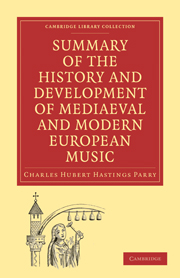Book contents
- Frontmatter
- PREFACE
- Contents
- CHAPTER I THE MUSIC OF THE MIDDLE AGES
- CHAPTER II MUSIC IN ENGLAND FROM THE BEGINNING OF TUDOR TIMES TILL THE RESTORATION OF THE STUARTS
- CHAPTER III THE BEGINNINGS OF OPERA AND ORATORIO
- CHAPTER IV THE PROGRESS OF OPERA IN VARIOUS COUNTRIES, FROM THE MIDDLE OF THE SEVENTEENTH CENTURY TILL THE TIME OF GLUCK
- CHAPTER V ORATORIO IN THE TIME OF BACH AND HANDEL
- CHAPTER VI THE PROGRESS OF INSTRUMENTAL MUSIC UP TO THE TIME OF J. S. BACH
- CHAPTER VII THE PROGRESS OF INSTRUMENTAL MUSIC IN THE EIGHTEENTH CENTURY
- CHAPTER VIII OPERA IN GLUCK AND MOZART'S TIME, AND IMMEDIATELY AFTER
- CHAPTER IX THE PROGRESS OF INSTRUMENTAL MUSIC TO BEETHOVEN AND HIS IMMEDIATE SUCCESSORS
- CHAPTER X MODERN INSTRUMENTAL MUSIC
- CHAPTER XI MODERN OPERA
- CHAPTER XII MODERN VOCAL MUSIC
CHAPTER IX - THE PROGRESS OF INSTRUMENTAL MUSIC TO BEETHOVEN AND HIS IMMEDIATE SUCCESSORS
Published online by Cambridge University Press: 29 August 2010
- Frontmatter
- PREFACE
- Contents
- CHAPTER I THE MUSIC OF THE MIDDLE AGES
- CHAPTER II MUSIC IN ENGLAND FROM THE BEGINNING OF TUDOR TIMES TILL THE RESTORATION OF THE STUARTS
- CHAPTER III THE BEGINNINGS OF OPERA AND ORATORIO
- CHAPTER IV THE PROGRESS OF OPERA IN VARIOUS COUNTRIES, FROM THE MIDDLE OF THE SEVENTEENTH CENTURY TILL THE TIME OF GLUCK
- CHAPTER V ORATORIO IN THE TIME OF BACH AND HANDEL
- CHAPTER VI THE PROGRESS OF INSTRUMENTAL MUSIC UP TO THE TIME OF J. S. BACH
- CHAPTER VII THE PROGRESS OF INSTRUMENTAL MUSIC IN THE EIGHTEENTH CENTURY
- CHAPTER VIII OPERA IN GLUCK AND MOZART'S TIME, AND IMMEDIATELY AFTER
- CHAPTER IX THE PROGRESS OF INSTRUMENTAL MUSIC TO BEETHOVEN AND HIS IMMEDIATE SUCCESSORS
- CHAPTER X MODERN INSTRUMENTAL MUSIC
- CHAPTER XI MODERN OPERA
- CHAPTER XII MODERN VOCAL MUSIC
Summary
While Haydn and Mozart were applying their great powers to the advancement of the highest forms of instrumental music, some very valuable work was being done in various subordinate branches by other composers and performers, of considerable though less comprehensive powers. The prominent position taken by the pianoforte in modern music gives special importance to the work of Muzio Clementi, who was the first composer to show a clear perception of the style of performance required by that instrument as distinguished from the old harpsichord. Till he applied his mind to the subject composers had mainly kept to the quiet gliding style suitable to the older instrument, and hardly realised the effects and contrasts which were obtainable by the more forcible and energetic treatment which was invited by the use of hammers instead of jacks as a means of producing the sound. Clementi was born in Rome in 1752. He was solidly grounded in contrapuntal studies, and came before the public as a composer, with a mass, at the age of fourteen. He was brought to England by a rich amateur while still quite young, and made his first appearance in London in 1777; and with the exception of a few professional tours through Europe he remained in this country for the rest of his life. He was of a practical turn of mind, and, besides establishing a very good position as a teacher and a performer and a conductor at the opera, he founded a pianoforte business, which still exists as Messrs. Collard and Collard.
- Type
- Chapter
- Information
- Publisher: Cambridge University PressPrint publication year: 2009First published in: 1893



